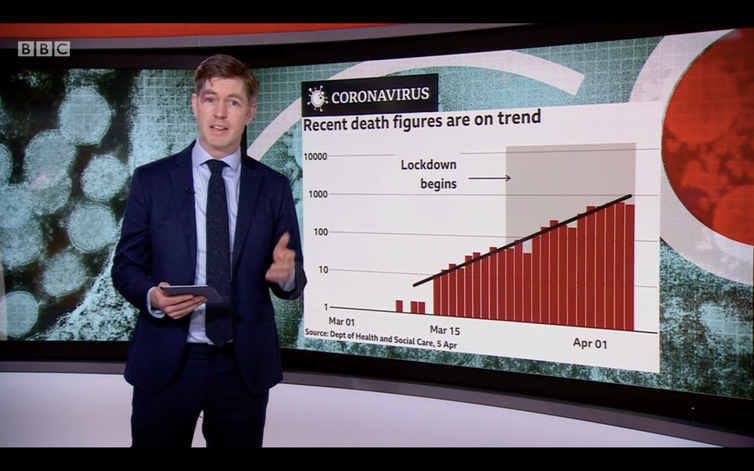Seeing a daily coronavirus death toll might actually make us take more risks
People are currently being bombarded with reports of the daily death toll from coronavirus. Practically every news website and channel displays the number prominently at all times. These figures provide important data to statisticians but what effect are they having on the rest of us?
Daily death figures allow experts to more accurately estimate the spread of the virus because they provide an objective benchmark that corrects for international differences in testing and reporting. They provide useful feedback to help gauge the impact of protective measures as we attempt to “flatten the curve”. But do they benefit the general public?
An obvious direct effect for the rest of us is that these figures remind us of the dreadful outcomes that result from breaching the guidance on handwashing and physical distancing. Rational decision-making is informed by two factors: risk and reward. Reporting the daily death toll reminds us to behave prudently. We remember that there is a meaningful risk of a tragically negative reward if we don’t.
But there are also less obvious – and less conscious – effects. In recent decades, experimental social psychologists have tested what happens when we prompt people to think about death.
What motivated their research is termed Terror Management Theory (TMT). It is rooted in theories of Sigmund Freud and philosopher Søren Kierkegaard and was given coherent expression in Ernest Becker’s Pulitzer Prize-winning book Denial of Death. The premise is that we have evolved elaborate mechanisms to mitigate the existential concerns resulting from the awareness that we will someday suffer physical death. The practical implication is that our motivations (and hence our real-world behaviours) can change when we are confronted with thoughts of death.
Experiments in the TMT field show that prompting death-related thoughts can increase risky behaviour. That is quite contrary to the rational risk-reward calculus articulated above. The logic is that risk-taking can be a source of self-esteem and one common way of coping with the inescapable threat of death is to bolster our self-esteem. Hence, reminders that smoking kills can actually increase smokers’ cravings and reminding drivers of the risk of death can increase speeding for some.
Gambling with life
It’s not just the fact of mentioning death that plays a part, either. The high numbers involved in these particular circumstances may also have an independent effect.
A set of studies made participants responsible for managing a hypothetical epidemic that would kill 600 people. Participants could choose a program that would result in 400 deaths or another that offered a one in three chance of saving everyone and a two in three chance of letting all 600 die. Participants from countries that had experienced several disasters in which hundreds of people had died (relative to those from countries where such disasters were extremely rare) were more willing to accept 400 deaths.
Another study from the same paper has even greater relevance: it found that participants were more willing to accept 400 deaths after reading a series of headlines in which a high (versus low) number of deaths were reported.
In short, when you encounter news that hundreds of people just like your neighbours have died in the past day, there are consequences for your judgement and decision-making. You are unlikely to be conscious of some of these consequences and, contrary to what the media and officials would wish, they might make you sensitive to the risks that we now face.

So what is a responsible editor to do? TMT suggests how mortality statistics might be presented without inducing unconscious effects. The key is that death is less threatening when it is explicitly linked to values we admire. Heroes typically embody the traits that we would like to see continue into future generations, and so relating thoughts of death to heroism can serve as a buffer against existential concerns.
Experiments show that prompting thoughts of heroes and heroism reduces the tendency to fixate on death. For instance, after having been prompted to think about death, participants who had earlier read a case of heroic self-sacrifice (saving a child from a burning car) were substantially less likely than others to form death-related words in a word-completion task. They were more likely to complete the puzzle C O F F _ _ as COFFEE whereas people asked to think about death but not shown a case of heroic self-sacrifice were more likely to complete it as COFFIN.
What are the practical implications of this? Well, headlines that explicitly mention the heroism of NHS workers alongside death tolls would be expected to allay mortality concerns. In this way, the communication of death-related information might avoid some of the negative biases, attitudes and behaviours instilled by mortality reminders.
We are living in exceptional times, as daily news reports remind us. There is an onus on the media to ensure that messaging doesn’t make matters worse.
This article is republished from The Conversation under a Creative Commons license. Read the original article.

The authors do not work for, consult, own shares in or receive funding from any company or organisation that would benefit from this article, and have disclosed no relevant affiliations beyond their academic appointment.

